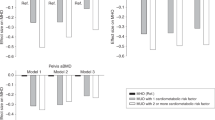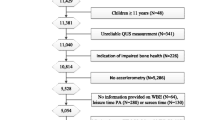Abstract
Overweight, physical inactivity and sedentary behaviour have become increasing problems during the past decade. Increased sedentary behaviour may change the body composition (BC) by increasing the fat mass relative to the lean mass (LM). These changes may influence bone health to describe how anthropometry and BC predict the development of the bone accruement. The longitudinal study is a part of The CHAMPS study-DK. Children were DXA scanned at baseline and at 2-year follow-up. BC (LM, BF %) and BMC, BMD and BA were measured. The relationship between bone traits, anthropometry and BC was analysed by multilevel regression analyses. Of the invited children, 742/800 (93 %) accepted to participate. Of these, 682/742 (92 %) participated at follow-up. Mean (range) of age at baseline was 9.5 years (7.7–12.1). Height, BMI, LM and BF % predicted bone mineral accrual and bone size positively and independently. Height and BMI are both positive predictors of bone accruement. LM is a more precise predictor of bone traits than BF % in both genders. The effects of height and BMI and LM on bone accruement are nearly identical in the two genders, while changes in BF % have different but positive effects on bone accretion in both boys and girls.


Similar content being viewed by others
References
Burckhardt P, Michel C (1989) The peak bone mass concept. Clin Rheumatol 8(Suppl 2):16–21
Berger C, Goltzman D, Langsetmo L, Joseph L, Jackson S, Kreiger N, Tenenhouse A, Davison KS, Josse RG, Prior JC, Hanley DA (2010) Peak bone mass from longitudinal data: implications for the prevalence, pathophysiology, and diagnosis of osteoporosis. J Bone Miner Res 25:1948–1957
Johnston CC Jr, Slemenda CW (1994) Peak bone mass, bone loss and risk of fracture. Osteoporos Int 4(Suppl 1):43–45
Dimitri P, Wales JK, Bishop N (2010) Fat and bone in children: differential effects of obesity on bone size and mass according to fracture history. J Bone Miner Res 25:527–536
Dimitri P, Bishop N, Walsh JS, Eastell R (2012) Obesity is a risk factor for fracture in children but is protective against fracture in adults: a paradox. Bone 50:457–466
Goulding A, Grant AM, Williams SM (2005) Bone and body composition of children and adolescents with repeated forearm fractures. J Bone Miner Res 20:2090–2096
Goulding A, Taylor RW, Jones IE, McAuley KA, Manning PJ, Williams SM (2000) Overweight and obese children have low bone mass and area for their weight. Int J Obes Relat Metab Disord 24:627–632
Goulding A, Jones IE, Taylor RW, Manning PJ, Williams SM (2000) More broken bones: a 4-year double cohort study of young girls with and without distal forearm fractures. J Bone Miner Res 15:2011–2018
Reilly JJ, Methven E, McDowell ZC, Hacking B, Alexander D, Stewart L, Kelnar CJ (2003) Health consequences of obesity. Arch Dis Child 88:748–752
Sudhagoni RG, Wey HE, Djira GD, Specker BL (2012) Longitudinal effects of fat and lean mass on bone accrual in infants. Bone 50:638–642
Zemel B (2013) Bone mineral accretion and its relationship to growth, sexual maturation and body composition during childhood and adolescence. World Rev Nutr Diet 106:39–45
Schoenau E, Fricke O (2008) Mechanical influences on bone development in children. Eur J Endocrinol 159(Suppl 1):S27–S31
Janz KF, Burns TL, Levy SM (2005) Tracking of activity and sedentary behaviors in childhood: the Iowa Bone Development Study. Am J Prev Med 29:171–178
Wedderkopp N, Froberg K, Hansen HS, Andersen LB (2004) Secular trends in physical fitness and obesity in Danish 9-year-old girls and boys: Odense School Child Study and Danish substudy of the European Youth Heart Study. Scand J Med Sci Sports 14:150–155
Wedderkopp N, Jespersen E, Franz C, Klakk H, Heidemann M, Christiansen C, Moeller NC, Leboeuf-Yde C (2012) Study protocol. The Childhood Health, Activity, and Motor Performance School Study Denmark (The CHAMPS-study DK). BMC Pediatr 12:128
Heidemann M, Molgaard C, Husby S, Schou A, Klakk H, Moller N, Holst R, Wedderkopp N (2013) The intensity of physical activity influences bone mineral accrual in childhood: the childhood health, activity and motor performance school (the CHAMPS) study, Denmark. BMC Pediatrics 13:32
Margulies L, Horlick M, Thornton JC, Wang J, Ioannidou E, Heymsfield SB (2005) Reproducibility of pediatric whole body bone and body composition measures by dual-energy X-ray absorptiometry using the GE Lunar Prodigy. J Clin Densitom 8:298–304
Duke PM, Litt IF, Gross RT (1980) Adolescents’ self-assessment of sexual maturation. Pediatrics 66:918–920
Tanner JM (1952) The assessment of growth and development in children. Arch Dis Child 27:10–33
Klakk H, Chinapaw M, Heidemann M, Andersen LB, Wedderkopp N (2013) Effect of four additional physical education lessons on body composition in children aged 8–13 years—a prospective study during two school years. BMC Pediatr 13:170
Carvalho WR, Goncalves EM, Ribeiro RR, Farias ES, Carvalho SS, Guerra-Junior G (2011) Influence of body composition on bone mass in children and adolescents. Rev Assoc Med Bras 57:662–667
Siervogel RM, Demerath EW, Schubert C, Remsberg KE, Chumlea WC, Sun S, Czerwinski SA, Towne B (2003) Puberty and body composition. Horm Res 60:36–45
Ivuskans A, Latt E, Maestu J, Saar M, Purge P, Maasalu K, Jurimae T, Jurimae J (2012) Bone mineral density in 11-13-year-old boys: relative importance of the weight status and body composition factors. Rheumatol Int. doi:10.1007/s00296-012-2612-0
Gracia-Marco L, Ortega FB, Jimenez-Pavon D, Rodriguez G, Castillo MJ, Vicente-Rodriguez G, Moreno LA (2012) Adiposity and bone health in Spanish adolescents. The HELENA study. Osteoporos Int 23:937–947
Heidemann M, Molgaard C, Husby S, Schou AJ, Klakk H, Moller NC, Holst R, Wedderkopp N (2013) The intensity of physical activity influences bone mineral accrual in childhood: the childhood health, activity and motor performance school (the CHAMPS) study, Denmark. BMC Pediatr 13:32
Heidemann M, Jespersen E, Holst R, Schou AJ, Husby S, Molgaard C, Wedderkopp N (2013) The impact on children’s bone health of a school-based physical education program and participation in leisure time sports: the Childhood Health, Activity and Motor Performance School (the CHAMPS) study, Denmark. Prev Med 57:87–91
Krabbe S, Christiansen C, Rodbro P, Transbol I (1979) Effect of puberty on rates of bone growth and mineralisation: with observations in male delayed puberty. Arch Dis Child 54:950–953
Acknowledgments
The authors gratefully acknowledge the work of numerous students and PhD students who have participated in the data collection for the CHAMPS study-DK. We thank children, parents and teachers in the schools involved in the project, and we are grateful for the cooperation with “Elitesekretariatet” in the municipality of Svendborg. The study had not been possible without financial support from The Nordea foundation, The TRYG foundation, The IMK foundation, The Region of Southern Denmark, The Egmont Foundation, The A. J. Andersen Foundation, The Danish Rheumatism Association, and TEAM Denmark.
Conflict of interest
Malene Heidemann, René Holst, Anders J. Schou, Heidi Klakk, Steffen Husby, Niels Wedderkopp, Christian Mølgaard state that they have no conflicts of interest and no disclosures.
Human and Animal Rights and Informed Consent
Children and parents received verbal and written information about the study. Participation in the study was at any time voluntary. The parents signed informed consent forms. Permission to conduct The CHAMPS Study–DK was granted by the Regional Scientific Ethics Committee (Project Number: S-20080047).
Author information
Authors and Affiliations
Corresponding author
Rights and permissions
About this article
Cite this article
Heidemann, M., Holst, R., Schou, A.J. et al. The Influence of Anthropometry and Body Composition on Children’s Bone Health: The Childhood Health, Activity and Motor Performance School (The CHAMPS) Study, Denmark. Calcif Tissue Int 96, 97–104 (2015). https://doi.org/10.1007/s00223-014-9941-9
Received:
Accepted:
Published:
Issue Date:
DOI: https://doi.org/10.1007/s00223-014-9941-9




